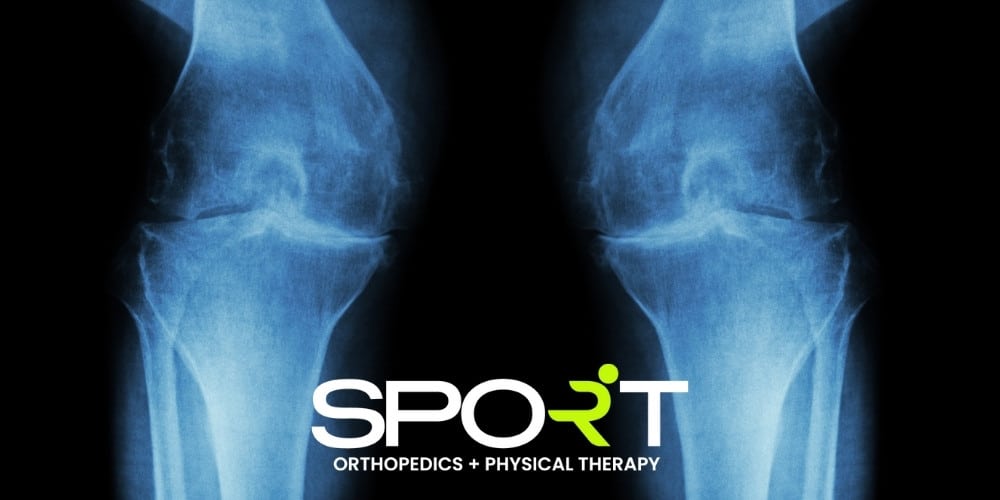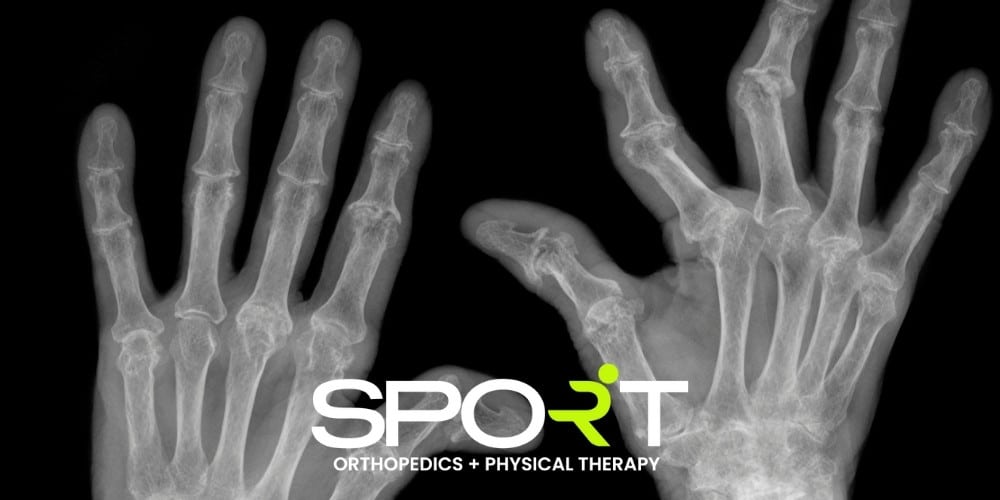
Osteoarthritis and rheumatoid arthritis are two of the most common forms of arthritis. In fact, osteoarthritis is the most common form of arthritis. Rheumatoid is considered to be the most debilitating form of arthritis. Both of these conditions fall under the large umbrella category of arthritis, but they are notably different in many ways. If you’re suffering from joint pain and you’re unsure of which of these conditions is affecting you, read our blog about the differences between osteoarthritis vs rheumatoid arthritis to learn more.
At SPORT Orthopedics + Physical Therapy, we take great pride in utilizing only the best diagnostic and treatment techniques. As the orthopedic industry changes and adapts, so do we. Our orthopedic specialists are committed to our patients in the Dallas and Frisco areas. If you’re suffering from minor joint aches, crippling pain, morning stiffness, or other serious symptoms, it may be time to visit one of our specialists. To schedule an appointment with us, please call our office today at 469-200-2832.

Arthritis is a medical term that refers to disease or pain in the joints of the body. It is an umbrella term that encompasses more than 100 total types of arthritis. It can affect multiple joints in one body, develop gradually or quickly, and have many different symptoms. Arthritis also affects people of all ages, races, and genders. It is also the leading cause of disability in the United States.
The most common symptoms of arthritis include reduced range of motion, swelling, pain, and stiffness in the joints. Depending on the type of arthritis, as well as its severity, these symptoms can range from minor to very serious. Some people have no difficulties living their lives with arthritis, while others suffer from intense pain and joint problems. It can even cause permanent joint damage in some cases.
The key takeaway here is that arthritis cannot be easily described by one word when it takes so many different forms. A better way to understand arthritis is to look at the differences between two common forms of it: RA and OA (rheumatoid arthritis and osteoarthritis).

Osteoarthritis (OA) is far and away the most common form of arthritis, as it affects millions of people all around the world. When the cartilage that cushions and protects the joints wears down over time, this is called osteoarthritis. This form of arthritis can affect virtually any joint in the body.
In most cases, the symptoms of osteoarthritis develop slowly over time. OA symptoms also tend to worsen as time goes on. The most common symptoms of osteoarthritis are as follows.
Osteoarthritis occurs mostly as a result of wear and tear of the joints over time. The cartilage within your joints is what cushions your bones and allows them to move against each other with as little friction as possible. When this cartilage deteriorates over time, the affected joints move less smoothly. With enough time, the cartilage could deteriorate completely, resulting in bone rubbing against bone.
Certain risk factors can increase one’s chances of developing osteoarthritis. These risk factors are as follows.
In order to diagnose OA, we will begin by taking a medical history and performing a physical examination of the affected joint. Then, we usually order certain imaging tests, such as X-rays or MRIs. If your doctor wants to rule out other conditions, they may order blood tests. However, it is usually enough to order X-rays for an OA diagnosis.
No. While the exact causes of osteoarthritis are not known, it is not the result of any immune system malfunctions. Instead, it is a condition that develops due to the wear and tear on the joints over time.

In many cases, rheumatoid arthritis affects more than just the joints in your body. This chronic inflammatory condition can cause joint damage as well as damage to other healthy tissues in your body, such as your heart, skin, lungs, and eyes. Because it is an autoimmune disorder, the immune system attacks the healthy joints and tissues in your body. It also affects the lining in your joints, causing swelling that can eventually lead to deformity of the joints as well as bone erosion.
The signs and symptoms of rheumatoid arthritis are as follows.
The first symptom you experience will likely occur in the small joints of your body, such as in your fingers and toes. It can progress over time to the large joints, such as your knees, hips, or shoulders. In most cases, the symptoms occur to the same joints on both sides of the body.
Approximately 40% of people who suffer from RA will experience other symptoms that do not affect their joints.
The specific causes or triggers of rheumatoid arthritis are unknown. However, it is an immune system disorder in which your body mistakenly attacks its own healthy cells. Possible risk factors for developing the condition include the following.
As with osteoarthritis, your doctor will begin by looking at your medical history, as well as performing a physical exam. The condition is often hard to diagnose in its early stages, as its symptoms mimic that of many other conditions. Some of the diagnostic tests that your doctor may perform include the following.
Yes. It is both an autoimmune disease and an inflammatory condition. When someone suffers from RA, their immune system attacks the healthy tissues in their body. Specifically, RA targets the lining of the joints. The swelling and inflammation associated with RA can also cause damage to other parts of the body, such as the skin, blood vessels, and certain organs.

Although RA and OA are both forms of arthritis, the two conditions have important differences. Osteoarthritis is the most common type of arthritis. It affects the cartilage that caps the ends of the bones in your joints. RA, on the other hand, affects the lining of the joints. Additionally, OA is more of a wear-and-tear condition. RA is an autoimmune disorder. These are the main differences between RA and OA.
Technically, yes. For example, someone who suffers a joint injury can develop both OA and RA as they age. Additionally, those who have rheumatoid arthritis can also develop osteoarthritis as a result.
Osteoarthritis most commonly affects the hands, feet, neck, back, hips, and knees. Rheumatoid arthritis most commonly affects the hands, feet, wrists, ankles, knees, shoulders, and elbows.

At SPORT Orthopedics + Physical Therapy, we take great pride in our work. We have extensive experience helping our patients treat and manage their arthritis. If you suffer from painful arthritis that affects your daily life, we have a wide range of treatments available to you. To schedule an appointment with the best Dallas orthopedic surgeon, please contact our office today at 469-200-2832.









*We accept most all insurance plans, if you do not see your plan listed above or have any questions, please contact our office.

SPORT Orthopedics + Physical
Therapy – Dallas, TX
Services:
• Clinic • Orthopedic • Urgent Care
• Physical Therapy
18152 Preston Road
Suite I-2
Dallas, TX 75252
Phone: (469) 200-2832
Fax: (469) 269-1074
SPORT Orthopedics + Physical Therapy – Frisco, TX
Services:
• Clinic • Orthopedic • Urgent Care
• Physical Therapy
9255 Dallas Parkway
Suite I20
Frisco, TX 75033
Phone: (469) 200-2832
Fax: (469) 269-1074
SPORT Orthopedics + Physical
Therapy – Wylie, TX
Services:
• Clinic • Orthopedic • Urgent Care
• Physical Therapy
3400 FM 544
Suite 650
Wylie, TX 75098
Phone: (469) 200-2832
Fax: (469) 269-1074
SPORT Physical
Therapy – Prosper, TX
Services:
• Physical Therapy
790 N Preston Rd
Suite 60
Prosper, TX 75078
Phone: (469) 850-0201
Fax: (469) 269-1074
SPORT Orthopedics – Mesquite, TX
Services:
• Clinic
• Orthopedic
• Urgent Care
1102 North Galloway Ave
Mesquite, TX 75149
Phone: (469) 200-2832
Fax: (469) 269-1074